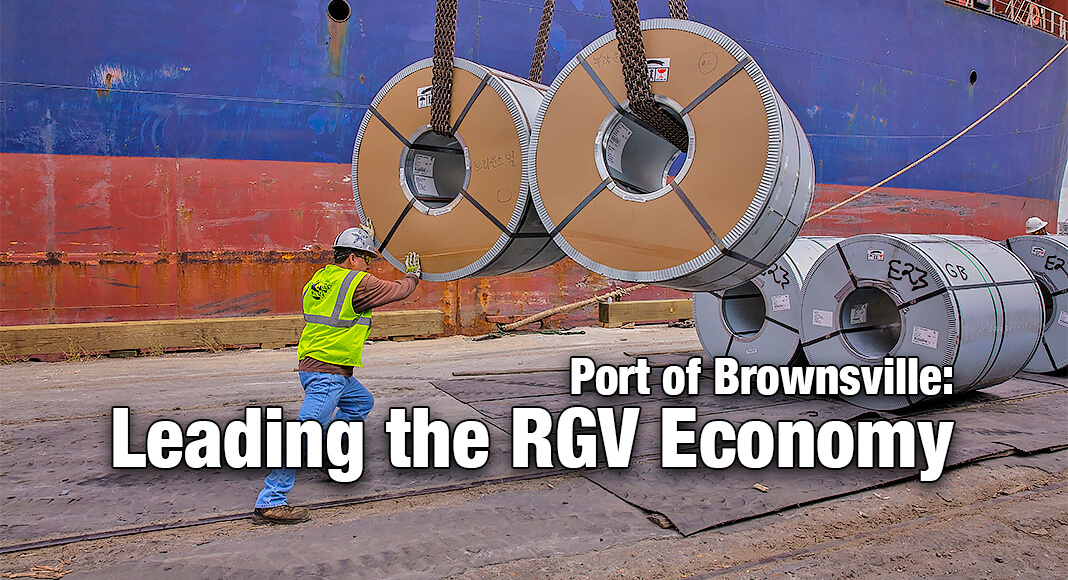
Texas Border Business
PORT of BROWNSVILLE – The future of the Rio Grande Valley’s economy is anchored at the Port of Brownsville. As the only deepwater seaport located on the U.S.-Mexico border, the port’s influence extends beyond Texas.
The U.S. Army Corps of Engineers Annual Report features the port’s ascension to 50th position among 150 U.S. maritime ports for waterborne cargo. In 2022, the port handled 9.1 million tons of cargo, up from 8.9 million tons in 2021, moving from 55th to 50th place.
The port’s comprehensive logistical network comprised of rail, trucking lines, vessel and barge services and pipeline connectivity are key to the successful transportation of goods as the port accommodates a variety of industries.
In 2023, total cargo tonnage at the port increased 17 percent to 17.8 million tons, with 12.3 million tons of waterborne and 5.5 million tons of non-waterborne cargo. The increased cargo activity has resulted in increased operating revenues as well. For the fourth consecutive year, the operating revenues at the port surpassed the $30 million mark, exceeding $41 million in 2023.
Prudent financial management, guided by the strategic and thoughtful planning of the Brownsville Navigation District (BND) Board of Commissioners, safeguards the interests of port tenants, users, constituents, and assets. The five-member elected commission is chartered by the State of Texas and charged with setting port policy and approving major expenditures. BND Commission members are elected to four-year staggered terms and meet twice monthly, governing the activities of the port. The BND Commission is comprised of Chairman Esteban Guerra, Vice Chairman Sergio Tito Lopez, Secretary John Wood and Assistant Secretaries John Reed and Ernesto Gutierrez. The port’s administration is led by Port Director and CEO William Dietrich and Deputy Port Director of Operations Arturo Gomez.
The BND’s latest infrastructure investment, its 118-acre business park, is designed to accommodate industrial and manufacturing companies complementing the expansions of existing and future port tenants and customers. In April, the port held a groundbreaking ceremony for the business park’s first tenant, Westa Inc. The agricultural company will invest over $30 million to establish a state-of-the-art wheat flour mill and wheat storage silos at the Port of Brownsville. Once operational, the facility will employ 120 people.
The Brazos Island Harbor (BIH) Channel Improvement Project is a key component of ongoing infrastructure upgrades at the port, aimed at deepening the 17-mile-long ship channel from 42 feet to 52 feet. This increased depth will enhance navigability, ensure safer ship passage, and reduce transit times, significantly boosting the port’s competitiveness and attracting more investments.
The BIH project, divided into two phases, is funded through a Public-Private Partnership (P3) involving the U.S. Army Corps of Engineers (USACE), the Port of Brownsville, and NextDecade. In 2019, NextDecade announced a landmark agreement with the BND to fully fund Phase 1, which includes deepening the channel from the western boundary of its lease site to the channel entrance and developing two ship berths and a turning basin for the Rio Grande LNG facility. Phase 2, to be executed by the Port of Brownsville and the USACE, will deepen the channel from the turning basin area to Rio Grande LNG’s site. In March 2022, the federal government allocated $68 million for Phase 2 under the Infrastructure Investment and Jobs Act Appropriations Law. In August, the USACE awarded a $104 million contract to Callan Marine Ltd. for Phase 2 of the BIH project. Work is set to start in Fall 2024 and is expected to be completed by Summer 2026.
The deepening of the Brownsville Ship Channel is a monumental project that will set the Port of Brownsville on a strong path for the future. This investment ensures that the port remains a critical player in the global supply chain, supporting sustainable growth for diverse industries.
WORKING TOWARD A BRIGHTER FUTURE
Efficient operations at the Port of Brownsville are strengthened by its workforce. The Port of Brownsville is proud to support education initiatives and training opportunities to ensure the development of crucial skillsets for its workforce.
In April, the BND joined Texas Governor Greg Abbott and Texas A&M University System leaders for a groundbreaking ceremony for a new 30,000-square-foot advanced manufacturing training facility at the Port of Brownsville. The center will offer programs provided by the Texas A&M Engineering Extension Service (TEEX).
The new $30 million facility at the Texas A&M Rio Grande Valley Advanced Manufacturing Innovation Hub (RAMI) at the port is set for completion in mid-2026. Established in 2021 with Texas State Legislature funding, the RAMI hub aims to boost advanced manufacturing skills in the Rio Grande Valley, preparing residents for technical careers and stimulating the local economy.
The Port of Brownsville is solidifying its role as an essential player in Texas’ energy landscape with the construction of NextDecade Corporation’s Rio Grande LNG facility. At full development, Rio Grande LNG will be the largest privately funded project in Texas and will have the capability to deliver enough energy to heat and cool the equivalent of nearly 34 million U.S. households annually.
The project aligns with the port’s objectives of economic development and job generation, projecting to create over 5,000 local construction jobs during peak construction. Bechtel Energy Inc., the construction company contracted to build the Rio Grande LNG facility, is on schedule to complete Phase 1 of the project, which includes 3 liquefaction trains, 2 storage tanks, 2 loading jetties, among other infrastructure. As of June, the company reports a 24 percent overall project completion for Trains 1 and 2, while Train 3 overall project completion is 7.8 percent.
On the horizon is Glenfarne’s Texas LNG project, a 4 mtpa LNG export terminal to be constructed in the Port of Brownsville. The company has announced important offtake agreements and projects to make a final investment decision and begin construction in 2024.
The Port of Brownsville remains a leader in the movement of wind energy components, thanks to its logistical capabilities and strategic location along the U.S.-Mexico border.
The port excels in supporting the wind energy sector by handling oversized components like the largest windmill blades imported into the U.S. Its specialized equipment and skilled workforce manage these components efficiently for transport by vessel, barge, rail, and truck. This capability positions the Port of Brownsville as a leader in servicing the renewable energy industry and facilitates the flow of cargo and other goods related to the space industry from port docks to SpaceX’s neighboring facility Starbase.
To accommodate the increasing cargo loads, the Port of Brownsville has expanded its patio and laydown areas to safely store project cargo and wind energy components.
Information Source: The Port of Brownsville















